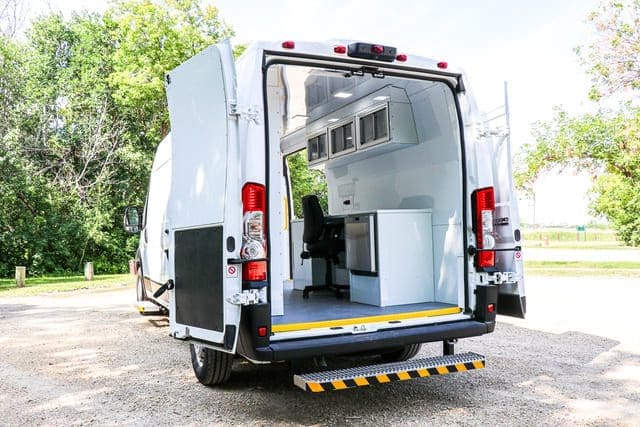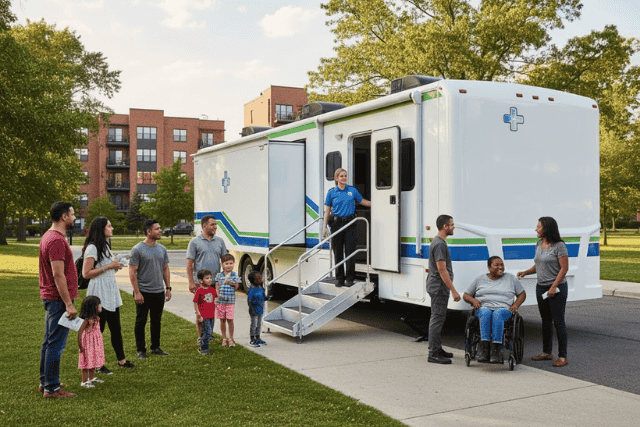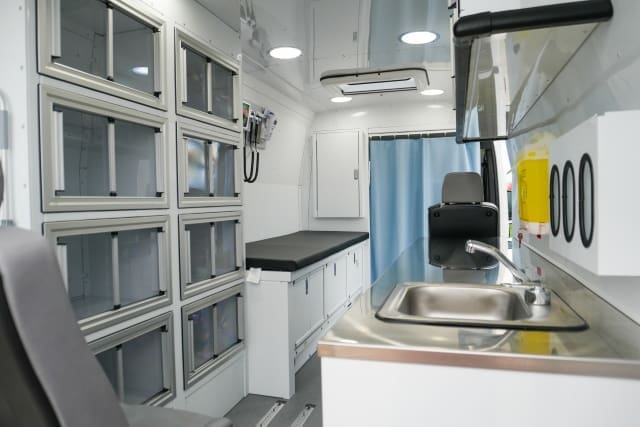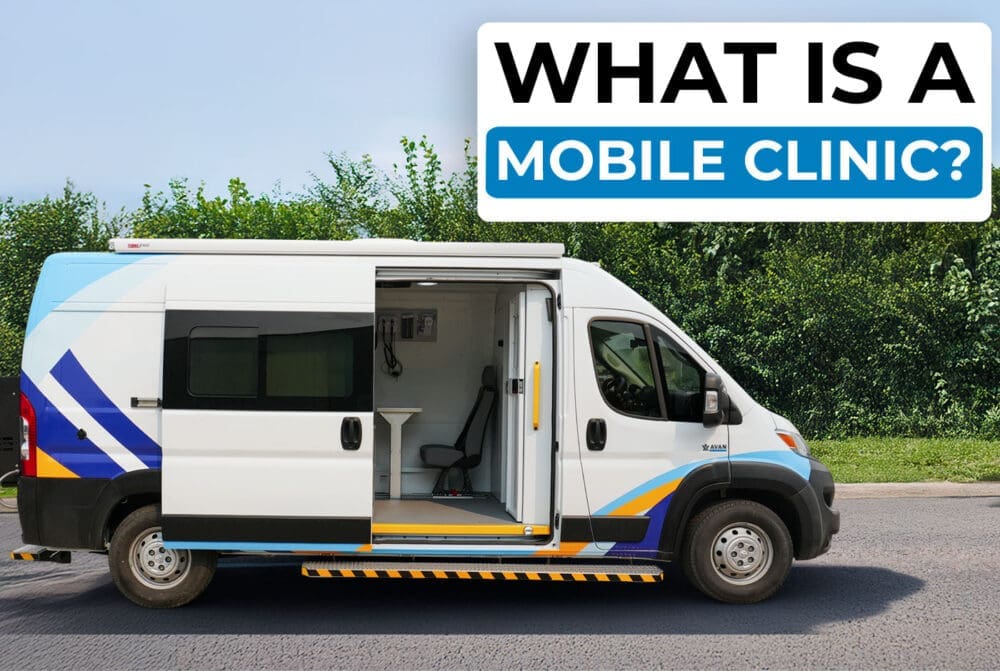Thinking about electric mobile medical units but unsure how they stack up against gas-powered ones? It’s an important choice, and it ultimately depends on what your organization needs most. Both options have their strengths and challenges, and knowing the differences can make it easier to decide what fits your goals.
We know making this decision can feel tricky. You have to think about costs, how reliable each option is, and how it will help you serve your community. It’s a big responsibility, but you’re not alone. Many organizations are asking the same questions and working through the same decisions.
At AVAN Mobility, we’ve been building mobile medical units for over 10 years. With certifications from Ford QVM and Stellantis QPro, we’re focused on creating vehicles that help people get better access to healthcare. While we know our stuff, this article is about helping you understand your options, not just talking about what we do.
Here’s what you’ll learn: A simple comparison of electric and gas-powered mobile medical units. By the end, we hope you’ll have the information you need to choose what’s right for your organization.
Pros of electric mobile medical units
If you’re considering an electric mobile medical unit, you might be wondering if it’s the right choice for your organization. Electric units offer a lot of benefits that could align with your goals, especially if you’re focused on sustainability, lower operating costs, and providing care within a local area.
Here are some key advantages to think about:
Lower fuel costs: Electricity is often cheaper than gas, so charging your unit can save money over time compared to filling a tank.
Environmentally friendly: Electric units produce zero emissions, which means they’re a greener choice. If sustainability is part of your mission, this could be a big win.
Quiet operation: Electric units are much quieter than gas-powered ones. This can be a benefit in neighborhoods or near clinics where noise might be a concern.
Easy to maintain: Fewer moving parts mean less upkeep. Electric units don’t need things like oil changes, and there’s less wear on brakes thanks to regenerative braking.
Perfect for short distances: With a range of about 163 miles on a full charge, electric units are great if your team isn’t traveling far each day. This is ideal for urban areas or organizations running local outreach programs.
Incentives and rebates: Many states and federal programs offer tax credits, rebates, or grants for electric vehicles. These incentives can help offset the initial cost and make going electric more affordable.
Electric units may not fit every situation, but their benefits can make a big difference for many organizations. Let me know when you’re ready for the next section!
Cons of electric mobile medical units
While electric mobile medical units have a lot of great benefits, they also come with a few challenges you’ll want to think about.
Here are some of the main ones:
Limited driving range: Remember how we mentioned the 163-mile range as a pro? Well, it can also be a con. If your team needs to travel longer distances in one day, this range might not be enough.
Charging takes time: Unlike filling up a gas tank, charging an electric unit can take a while. Even with fast chargers, it might take 30 minutes or more to get back on the road.
Hard to find charging stations: Depending on where you’re providing mobile healthcare, charging stations might not always be nearby. This can be especially tricky if your outreach takes you to rural areas.
Doesn’t handle cold as well: Electric vehicles can lose some range in colder weather. Using the heater or other features in the winter also uses extra battery power, which might make it harder to go as far on one charge. This could affect the reliability of your program in states like Alaska, North Dakota, and Wyoming, where winter temperatures can get quite cold.
Costs more upfront: Electric units can cost more to buy than gas-powered ones. While there are incentives to help with this, it’s still something to consider when planning your budget.
These challenges don’t make electric units a bad choice—they just mean you’ll need to decide if they match what your organization needs.
Pros of gas-powered mobile medical units
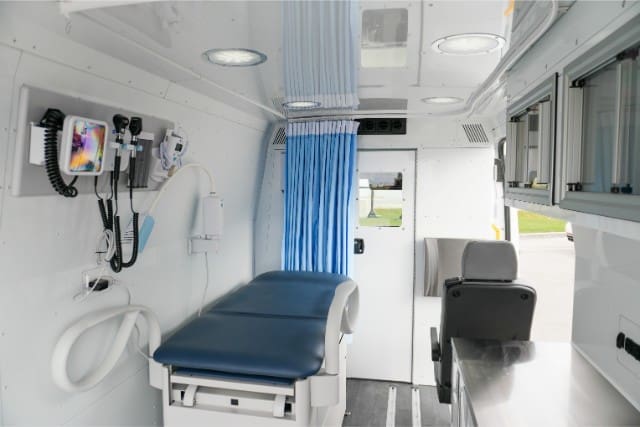
Gas-powered mobile medical units have been a reliable choice for years, and for good reason. They come with several benefits that might make them a great fit for your organization.
Here’s what to know:
Longer driving range: Gas-powered units can travel much farther than electric ones. On average, they achieve a range of 303+ miles per tank, with an efficiency of approximately 12.7 miles per gallon. This makes them ideal for long trips or covering larger service areas efficiently. Keep in mind that these numbers are just estimates, and actual fuel efficiency will vary.
Quick refueling: Unlike electric units, filling up a gas tank takes just a few minutes. This keeps your team moving and minimizes downtime during busy days.
Fuel is easy to find: Gas stations are everywhere. No matter if you’re working in urban areas like New York City, where gas stations are plentiful and often just a few blocks away, or in more remote locations like the vast landscapes of Montana, where you might need to travel a bit further to find a refuel, you’re never far from a refueling option.
Lower upfront cost: Gas-powered mobile medical vehicles usually cost less to buy compared to electric ones. If your organization’s budget is tight, this can make a big difference.
Well-known technology: Gas engines have been around for a long time, so finding mechanics and spare parts is simple. Repairs and maintenance are usually quicker and easier.
Gas-powered units are a dependable choice, especially for organizations that need to cover a lot of ground or don’t have access to electric charging stations.
Cons of gas-powered mobile medical units
While gas-powered mobile medical units have a lot of strengths, there are some downsides you should keep in mind. Here are the main ones:
Not great for the environment: Gas engines release emissions that pollute the air. If your organization has a strong focus on the environment, this may be something to consider.
Higher maintenance needs: Gas vehicles need more regular upkeep, like oil changes and engine repairs. Over time, these maintenance costs can add up. Gas engines also tend to experience more wear and tear due to the combustion process, which can lead to more frequent repairs and replacements of engine components.
Gas prices can go up and down. Gas prices aren’t always stable. They can jump unexpectedly, making it harder to plan your budget.
Noisy engines: Gas engines are louder than electric ones, which might not be ideal if you’re working in quiet neighborhoods or near hospitals.
While gas-powered units are a solid choice in many ways, it’s important to think about these challenges and decide if they align with your organization’s needs and goals.
Electric mobile medical units vs. gas-powered: Which should you choose?
When deciding between an electric or gas-powered mobile medical unit, there’s no one-size-fits-all answer. Both options have their own pros and cons, and the best choice depends on your organization’s unique needs. Let’s break it down to help you decide.
If your program is based in a warmer state like California, an electric unit could be the better choice—especially if:
- You drive short distances each day (just a few miles)
- Your area offers electric vehicle incentives or rebates
- You mostly operate in urban areas with charging stations nearby
- Your community values sustainability and reducing emissions
Why it makes sense:
- You’ll spend less on fuel
- It runs quietly, which is great for city streets or residential areas
- It’s eco-friendly, helping reduce your program’s carbon footprint
If your program runs in a colder state like Minnesota, where daily travel is longer and weather is harsher, a gas-powered unit might be a smarter fit.
Choose gas if:
- You often drive long distances (like 100–200 miles a day)
- You serve rural areas with limited charging infrastructure
- You deal with freezing temperatures that can affect battery range
- You want a vehicle that’s ready to go without waiting to charge
Why it makes sense:
- Reliable performance even in cold weather
- No need to plan routes around charging stations
- Great for programs on the move across big service areas
Ultimately, the choice between these options comes down to your priorities:
- Daily driving distance
- Geographic location and climate
- Access to charging or fuel stations
- Budget for upfront costs versus long-term savings
- Commitment to sustainability goals
Take some time to weigh these factors. The right choice is the one that aligns best with your mission and the communities you serve.
Want to learn more about electric mobile medical vehicles?
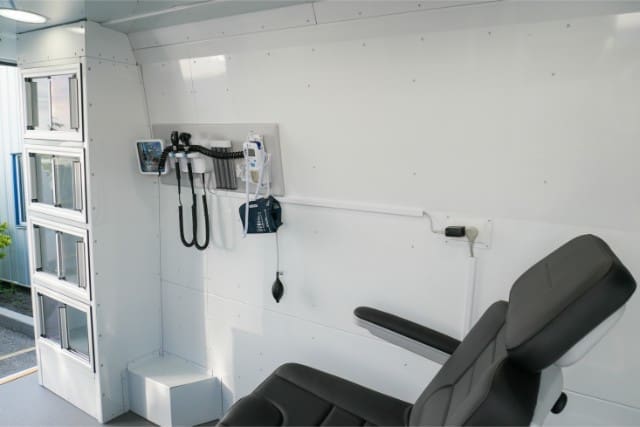
You came to this article because you’re deciding between an electric mobile medical unit and a gas-powered one. It’s a big decision, and understanding which option fits your organization best is critical to meeting your goals and serving your community effectively.
What you’ve learned:
- The pros and cons of both electric and gas-powered mobile medical units.
- Key factors to consider, like daily driving distance, location, and budget.
- Examples of how each option works best in different scenarios.
At AVAN Mobility, we understand the challenges organizations face when delivering healthcare on the move. Our team has worked with hundreds of organizations nationwide, from urban clinics to rural outreach programs, tailoring vehicles to meet specific operational needs.
We collaborate with our clients to ensure every detail, from design to functionality, supports their mission to serve communities effectively. With us, you’re investing in a solution that empowers your organization to save lives and remove barriers to care.
If you have any questions or want to talk through your options, click the button below to connect with one of our mobility experts. We’re here to help you every step of the way.
If you’re not ready to chat yet, we have plenty of other helpful resources you can check out to learn more.
Many organizations we talk to wonder if a van or RV is the right fit. Check out our comparison article to learn more.
After that, check out our series on mobile clinics. This is especially helpful if your organization is geared toward providing mobile healthcare.
